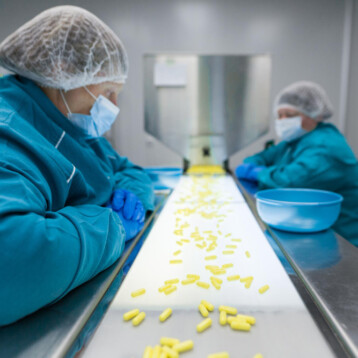|
Magnetic resonance imaging (MRI) scanners enable visualization of the structure and function of the human body. The scanners create powerful magnetic fields to which the hydrogen atoms in the body respond. The concentration of hydrogen atoms in water within living tissues is very high, the exact amount of water within the tissue varying between the different kinds of tissues. Therefore, each tissue produces a different magnetic resonance signal. Additional magnetic fields can manipulate this signal so that an image of the body is created. Using this method, scientists can analyze the specific signals from the part of the body that is being tested to determine which types of tissues are present.
MRI scanners typically require magnetic fields of a few Tesla (about 10,000 to 100,000 times stronger than Earth’s magnetic field). The powerful magnets necessary to generate these fields make scanners very expensive, as well as dangerous for people with metal implants. A new device developed in the Los Alamos National Laboratory in New Mexico, hits a sample with a 30 millitesla magnetic field, about 100 times weaker than the field normally used in MRI scanners. The device then uses a 46 microtesla magnetic field (about the same strength as Earth’s magnetic field) to capture images of the sample. The first target for imaging by this ultra-low field MRI scanner was the head of the scientist who led the research group, Vadim Zotev.
|
Ultra-low field MRI (ULF MRI) scanning was first performed in 2004 by a team of scientists led by John Clarke at University of California, Berkeley. However, the scanner utilized a single SQUID (superconducting quantum interference device, which is a very sensitive sensor) and was only capable of scanning objects about the size of an apple. The new device utilizes seven SQUIDs and can scan much larger objects.
Zotev points out several advantages of the Microtesla MRI over the high-field MRI. Since it requires less powerful magnets, the cost of the MRI examination can be dramatically reduced. Moreover, ultra-low field MRI machines can be much more open than the cylindrical MRI tubes common in clinics today, and may therefore enable placing medical equipment inside the machine and may be more suitable for a surgical environment. Zotev‘s group is currently completing the development of a new, larger, ULF MRI system that will be able to hold 2-3 people inside of it and is expected to demonstrate better performance (imaging quality and speed) than the current experimental system.
MRI machines used today can also be problematic for people with metal implants, since intense magnetic fields can move or heat the implants, causing damage to surrounding tissues. Although ultra-low field MRI can image materials even when metal is placed near the magnets, it hasn’t been tested on animals or people with metal implants and its absolute safety has yet to be proven.
The new device may also function as a magneto-encephalography (MEG) machine, which measures the feeble magnetic fields produced by electric activity in the brain. This advantage of an ultra-low field MEG is that it may ease surgeon’s identification of brain areas with abnormal activity (such as in epilepsy).
|
The researchers intend to perform a detailed study of imaging contrast at microtesla fields, particularly for the human brain. According to Zotev this is something that nobody has done in vivo. “Imaging contrast is generally improved at lower magnetic fields, and this may allow more efficient early diagnostics of various medical conditions”, he told TFOT.
Zotev believes that ULF MRI will be commercialized within approximately 5 years, and that in the future, simple, inexpensive, portable and patient-friendly ULF MRI may be widely used to image various parts of the human body.
A couple of other attempts to develop and improve living tissues’ imaging techniques were recently covered by TFOT. One of them is a computational three-dimensional image-forming technique developed at the University of Illinois for research and clinical uses. Another is a MEMS (Micro-Electro-Mechanical) based scanning technology for conducting confocal microscopy imaging in confined sections of the human body, developed at Stanford University. More recently, TFOT covered research conducted by scientists from the University of Illinois at Urbana-Champaign. The scientist developed a novel computational image-forming technique for optical microscopy, called ISAM, which has potential applications in medical clinical diagnosis, in cases where imaging is preferable to biopsy.
More information on the new SQUID based MRO can be found here (PDF).













